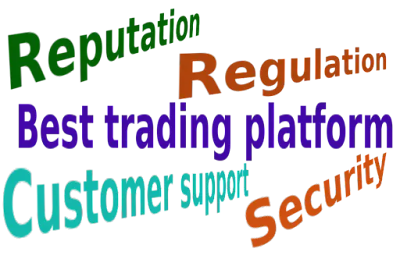Indicators in forex trading
Using indicators in forex is one of the most critical aspects of forex trading, and most of the traders use indicators and other technical analysis tools available on the platform. Indicators in the forex market are simply mathematical calculation tools that traders use to analyze the price movements and behavior of a currency pair. Indicators are commonly used by most traders to determine entry and exit points as well as define market trends. good, We appreciate your interest. Let's begin.
- 1. Technical Indicators
- 2. Trend-Following Indicators in forex
- 2.1. Moving Average (MA)
- 2.2. Bollinger bands indicator
- 2.3. (MACD) Moving Average Convergence Divergence
- 2.4. Parabolic SAR indicator
- 3. Support and Resistance Indicators in forex
- 4. Volatility Indicators
- 5. Overbought or Oversold Indicators
- 6. Some Momentum Indicators
- 7. Indicator Strategies
- 8. Conclusion
Technical Indicators
Hi and welcome to our website! These indicators provide traders with valuable information about current and upcoming market trends, price movements, and momentum.There are many different types of indicators available on the market, such as trend-following indicators, support and resistance indicators, volatility indicators, overbought and oversold indicators, and momentum indicators.
The moving average, the Relative Strength Index, the Moving Average Convergence Divergence (MACD), the parabolic SAR (Stop and Reverse), the Stochastic Oscillator, and the Fibonacci retracement. These indicators are the most commonly used by traders. Now let's see these types of indicators. ok guys, We love people who are enthusiastic and positive.
Trend-Following Indicators
Moving average
Moving average indicator is a line on the chart helps traders identify the average price of a currency pair and the trend on the current frame time period. By using a moving average indicator, traders can smoothen out price action, and detect potential buy and sell signals to make informed trading decisions. When the price is below the moving average, it's considered to be in a downtrend an when is above, it's considered to be in an uptrend.
To use indicators on metatrader 4, just click on the menu Insert -> Indicators...
How to choose Moving Average indicator
Bollinger Bands
This indicator consists of two standard deviation lines with a moving average indicator, which is used by traders to obtain more information about potential price movements. These standard deviation lines are typically plotted on charts below and above the moving average.
Traders in the forex market also use Bollinger to obtain necessary information about market volatility and identify potential price breakouts, all these things help them make informal trading decisions. A bullish signal is seen on charts when a price breakout occurs above the upper Bollinger Band, while a bearish signal occurs when a price breakout occurs below the lower Bollinger Band.
How to use Bollinger indicator
Moving Average Convergence Divergence (MACD)
MACD is often used to confirm trends and potential entry and exit points in the forex market. The MACD movement is calculated by subtracting the 26-period exponential moving average (EMA) from the 12-period exponential moving average. A negative MACD indicates that the 12-period EMA is trading below the 26-period EMA, while a positive MACD indicates trading above. (MACD) is another popular indicator for scalping.
How to choose Moving Average Convergence Divergence MACD
Parabolic SAR indicator
The parabolic SAR indicator is plotted on the chart as a series of dots depending on the direction of the trend. If the trend is down, the parabolic SAR is plotted above the price, and if the trend is up, the parabolic SAR is plotted below. This indicator is used by traders to determine potential entry and exit points in the market, as well as potential trend reversals. It generates the trend using a combination of the current price, the acceleration factor, and the maximum price. The acceleration factor increases as the trend continues and starts at a lower value. When the trend reverses, the acceleration factor decreases.
Feel free guys to send us an email if you have any questions at any point in time, We answer all messages we receive.
How to use parabolic SAR
Support and Resistance Indicators
Fibonacci retracement
The Fibonacci retracement indicator on allplatformsis used to identify levels of resistance and support in the forex market. These levels can help traders determine potential levels at which a currency pair can reverse direction. This indicator is calculated by plotting horizontal lines at specified Fibonacci levels between a currency pair’s high and low, such as 100%, 61.8%, 50%, 38.2%, and 23.6%. Fibonacci retracement is the most used indicator by forex traders and those who are looking for a strategy that can generate quick profits with tight stop losses.
Volatility Indicators in forex
Bollinger Indicators
Since this indicator is a trend-following indicator, it's also considered a volatility indicator due to its usefulness, simplicity, and benefits that traders use to identify the volume of volatility on the forex market.
Overbought/Oversold Indicators
Relative Strength Index (RSI)
Relative Strength Index is a technical indicator introduced in 1978 and widely used by traders in the stock, forex, and commodity markets to determine the strength of price action. The RSI indicator generates a signal that helps traders determine whether the currency pair for the current time period is oversold or overbought after measuring the velocity and magnitude of price changes. The RSI indicator ranges from 0 to 100, a bullish reversal signal may occur when the RSI moves from below 30 to above 50, and a bearish reversal signal may occur when the RSI moves from above 100 to below 70.
How to use Relative Strength Index
Stochastic Oscillator
The stochastic oscillator indicator is usually used by traders to measure the location of the current price relative to the price range over a specified time period. The stochastic oscillator ranges from 0 to 100, with readings above 80 indicating an overbought market and readings below 20 indicating an oversold market. The stochastic oscillator can be used to identify potential trend reversals and confirm price movements. For example, a bullish reversal signal may occur when the stochastic oscillator moves from below 20 to above 50.
How to use Stochastic Oscillator indicator
Momentum Indicators
Relative Strength Index (RSI)
The Relative Strength Index indicator is also considered a momentum tool that traders in the forex market use to identify potential trend reversals and confirm price movements by comparing the magnitude of recent gains to recent losses to measure the strength of a trend. The Relative Strength Index ranges from 0 to 100, with readings below 30 indicating an oversold market and readings above 70 indicating an overbought market. The RSI can be used.
Stochastic Oscillator in forex
The stochastic oscillator indicator was developed by George Lane in the 1950s and is used to determine the momentum of a currency's price action and if a currency pair is overbought or oversold. The stochastic oscillator is plotted on a scale of 0 to 100 and calculated by comparing the closing price of a currency pair to its price range over a specified number of time periods. If values are below 20, indicating that a currency is oversold, it signals a potential buying opportunity, if values are above 80, indicating that a currency is overbought, it signals a potential selling opportunity. The stochastic oscillator is a momentum-based indicator and therefore more effective in trending markets.
Some Indicator Strategies
Traders in the forex market typically use a trend-following strategy using indicators available on metatrader platform such as moving averages, Bollinger, and Moving Average Convergence Divergence (MACD) to identify the direction of the trend in addition to their technical analysis and risk management plan. This helps make trading decisions accordingly. The trend-following strategy is based on the idea of riding a trend to make profits.
For example, we only enter long trades (buy) when the moving average is pointing upwards, even when there are signals of the opposite trend, and we only enter short trades (sell) when the moving average is pointing downwards. (Trend is our friend). We should always trade in the direction of the trend.
In Momentum-based strategies, we use momentum indicators such as the Relative Strength Index (RSI) or the Stochastic Oscillator, to identify potential trend reversals and market momentum so we can make trading informal decisions and to make profits based on the idea of exploiting market momentum.
For example, when using the Relative Strength Index, if the indicator moves from above 100 to below 70, we enter a short trade (sell), and if it moves from below 20 to above 50, we enter a long trade (buy).
We take advantage of breakout strategies using volatility indicators such as Bollinger, based on the idea of exploiting price breakouts at the levels of support and resistance to identify potential price breakouts and make trading decisions accordingly.
For example, we enter a short trade (sell) when the price breaks below the lower Bollinger Band, and we enter a long trade (buy) when the price breaks above the upper Bollinger Band. Thank you for visiting our website. We hope you enjoyed your stay. Can I help you in any way? If you need any assistance, I’m always here. If you need support or help, please contact us at contact us page at the top menu.
Conclusion
In conclusion, with the right approach, indicators can be a valuable tool in our trading arsenal. In forex trading, we use indicators to effectively analyze the market and make informed trading decisions. However, we should understand the limitations of these indicators and use them in combination with technical analysis and other forms of fundamental analysis, such as price action and breakout strategies. Traders should also avoid overloading the charts with too many indicators, which leads to confusion and conflicting signals. It's very important to use the right combination of these indicators that align with our trading method.
These resources are useful for beginners who are new to the forex market and willing to learn more about how forex works.





